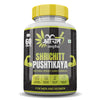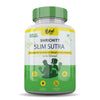Muscle development is essential for building a strong, healthy body that supports everyday life. Imagine waking up feeling energized, carrying groceries without strain, or climbing stairs effortlessly. These simple actions reflect the true power of muscle growth—it’s about more than just gaining weight on the scale. Developing muscle boosts your metabolism, enhances physical strength, and creates lasting vitality. Unlike focusing on numbers, muscle development builds confidence from within, improving how you move, feel, and live. Achieving muscle growth requires a balanced approach combining the right nutrition with consistent exercise. Prioritize protein-rich foods like lentils, paneer, and eggs to repair and build muscle tissue. Healthy fats from sources such as ghee and avocados support hormone production critical for muscle synthesis. Complex carbohydrates, including basmati rice and sweet potatoes, provide the energy needed for workouts and recovery. Pair this nutrition with strength-building exercises—such as push-ups, squats, or light weights—performed three to four times weekly. Consistency in your meals, workouts, and rest allows muscles to rebuild stronger over time. Muscle development refers to increasing lean muscle mass that directly improves your body’s function and strength. It goes beyond just adding pounds on the scale, focusing instead on creating a body capable of handling daily challenges with ease. This approach emphasizes muscle as a key to enhanced energy, resilience, and long-term health.
Why Muscle Matters More Than Weight
Imagine carrying your groceries up three flights of stairs without breaking a sweat, or feeling steady energy all day long. That’s the gift of muscle development—a strength that transforms daily life far beyond what a scale can show. Muscle matters more than weight because it powers your body’s performance, fuels your metabolism, and builds resilience for years to come. Here’s why prioritizing muscle over mere pounds creates a healthier, more vibrant you.
Functional Strength: Powering Everyday Life
Muscle development equips you to handle daily tasks with ease—think lifting heavy bags, climbing stairs, or playing with kids without tiring. Unlike fat gain, which adds weight but little function, muscle enhances your physical capacity. Research shows that strength training improves functional fitness by 20–30% within weeks, boosting movements like squatting or carrying. To assess your progress, try tracking how easily you perform tasks like push-ups or walking uphill. Building functional strength means a body that thrives in action, not just on a scale.
Metabolic Benefits: Fueling Energy and Balance
Muscle tissue is a metabolic powerhouse, burning 10–15 calories per pound daily at rest—three times more than fat. This higher resting metabolic rate (BMR) keeps your energy steady and supports weight gain without excess fat. For example, adding 5 pounds of muscle could increase your BMR by 50–75 calories daily, making it easier to maintain a healthy surplus. Studies confirm that muscle mass stabilizes blood sugar and boosts energy balance. Track your energy levels on a 1–10 scale daily to see how muscle growth fuels your vitality.
Ayurvedic Perspective: Grounding Vata, Building Ojas
In Ayurveda, muscle—known as Mamsa Dhatu—is a vital tissue that grounds Vata’s restless energy, fostering stability and strength. Strong muscles also nurture Ojas, the essence of vitality that radiates as glowing skin and robust immunity. According to traditional texts like the Charaka Samhita, nourishing Mamsa Dhatu with warm, protein-rich foods like dal or ghee supports tissue growth and emotional calm. Incorporate grounding practices like Abhyanga (oil massage) alongside muscle-building meals to enhance resilience. This holistic approach sets your body up for lasting vitality.
Long-Term Health: A Foundation for Lifelong Wellness
Muscle mass is your body’s armor against aging. It supports hormonal balance, boosting testosterone and growth hormone for better mood and recovery. Research shows that each pound of muscle increases bone density by 1–2%, reducing fracture risk. Muscle also strengthens immunity, helping you fend off illness faster. For those underweight, building muscle counters risks like sarcopenia (age-related muscle loss), ensuring vitality into your 40s and beyond. Track strength gains over months to see how muscle protects your future health.
Strength-Building Nutrients for Muscle Development
Muscle development is a slow, powerful transformation—not only in appearance but in how the body functions, moves, and recovers. To support this growth, the body relies on a precise balance of nutrients that provide the building blocks, energy, and recovery tools required for lean mass. This section breaks down the four key nutrient pillars that drive muscular strength and endurance.
1. Protein: The Structural Core of Muscle Repair
Muscle tissue rebuilds and grows stronger after being challenged—whether by strength training or daily movement. This repair process requires amino acids, which come from protein. Without consistent, high-quality protein intake, muscle synthesis remains incomplete.
- Optimal intake: 1.2–2.0 grams per kilogram of body weight daily. For a 60 kg individual, that’s 72–120 grams per day.
- Timing: Spread protein across 3–5 meals. Prioritize intake within 30–60 minutes post-exercise and consider a slow-digesting source like milk or paneer at bedtime.
- Best sources:
- Vegetarian: Paneer, moong dal, tofu, Greek yogurt
- Non-vegetarian: Eggs, chicken, fish (optional based on diet)
- Bioavailable combinations: Rice + dal, roti + curd, oats + milk
Proteins do more than build bulk—they improve muscle tone, immunity, and tissue repair, forming the core of true strength.
2. Healthy Fats: Fueling Hormones and Growth
Fats are often misunderstood, but they are foundational for muscle growth. They fuel hormone production, especially testosterone and growth hormone, both of which are directly involved in protein synthesis and muscle regeneration.
- Daily requirement: Roughly 25–35% of total calorie intake. For a 2,400 kcal/day plan, that’s 65–90 grams of fat.
- Sources of strength-supportive fats:
- Ghee: Rich in butyrate and CLA; boosts digestion and muscle repair
- Almonds & walnuts: Provide omega-3s and vitamin E
- Avocado & coconut oil: Enhance hormone balance and energy density
- Sesame oil: Ayurvedically recommended for building vitality (Bala)
3. Complex Carbohydrates: Glycogen Fuel for Muscle Power
Carbohydrates refill your glycogen stores—the body's primary energy source during resistance training. When glycogen is readily available, muscles perform with greater endurance, intensity, and recovery efficiency.
- Ideal intake: 3–6 grams per kilogram of body weight per day
- Best sources:
- Basmati rice: Easily digestible and effective post-workout
- Oats and millets: Slow-digesting for sustained energy
- Sweet potatoes and beets: Rich in antioxidants and complex starch
- Whole wheat chapati and poha: Ideal for Indian meal planning
- Timing: Include complex carbs in all meals; emphasize around workouts for peak fuel and recovery
4. Micronutrients: Silent Drivers of Strength and Recovery
Micronutrients may seem secondary, but they are the real facilitators of muscle development. Without key vitamins and minerals, the processes of energy metabolism, tissue repair, and muscle contraction can weaken.
- Zinc: Supports testosterone, muscle repair, and immunity
- Magnesium: Crucial for muscle relaxation and recovery after workouts
- B-Vitamins (B6, B12, folate): Fuel energy production and protein metabolism
- Iron: Carries oxygen to muscles during exertion
- Nutrient-rich sources:
- Nuts and seeds (especially pumpkin, sesame, flaxseed)
- Leafy greens (spinach, methi, moringa)
- Whole grains (millets, brown rice, amaranth)
- Legumes and lentils (chickpeas, moong, kidney beans)
A micronutrient-rich diet accelerates recovery, sharpens mental clarity, and allows muscles to adapt better after every training session.
Bringing It All Together
Building muscle is about synergy. Protein provides the bricks, fats light the internal fire, carbohydrates fuel the workers, and micronutrients direct the entire operation. When timed and balanced correctly, these nutrients work together to create real, lasting muscle growth that shows in strength, structure, and stamina.
Every well-cooked meal is an opportunity to build the body you envision—stronger, more energetic, and deeply nourished from the inside out.
Workouts to Drive Muscle Growth
Building muscle mass requires more than just eating well — it demands consistent, intelligent movement. The right workout plan doesn't just grow muscle, it transforms how the body feels, performs, and recovers. At the heart of this transformation is muscle hypertrophy — the process where muscle fibers adapt, strengthen, and grow in response to resistance.
This section outlines the four core pillars of effective muscle-building workouts: resistance training, progressive overload, strategic rest, and Ayurvedic balance. Whether you're a beginner or returning after a long gap, these approaches help you build strength that feels sustainable and deeply energizing.
1. Resistance Training: Stimulating Growth From Within
Resistance training is the primary driver of muscle hypertrophy. It creates the essential stress muscles need to adapt and expand. The goal isn't just to lift heavy weights — it's to activate key muscle fibers and progressively build strength through targeted movement.
Beginner-Friendly Options:
- Bodyweight Movements: Push-ups, squats, lunges, planks — highly effective for home workouts
- Resistance Bands: Add gentle resistance to enhance intensity without joint stress
- Light Dumbbells or Water Bottles: For progressive strength at home
Structure Your Week:
- Frequency: 3–4 sessions per week
- Target: Major muscle groups — chest, back, legs, shoulders, arms, and core
- Reps & Sets: 8–12 reps × 2–4 sets is optimal for hypertrophy
Example Split:
- Day 1: Upper Body (push-ups, overhead press, rows)
- Day 2: Lower Body (squats, lunges, bridges)
- Day 3: Core & Mobility (planks, leg raises, dynamic stretches)
- Day 4: Full Body or Active Recovery
2. How Progressive Overload Drives Consistent Muscle Growth
Muscle growth only happens when the body is challenged beyond its current capacity. This is where progressive overload becomes essential. By gradually increasing resistance, volume, or complexity, muscles adapt by becoming larger and stronger.
How to Apply Progressive Overload:
- Add Reps: If 10 push-ups feel easy, aim for 12–15 next week
- Increase Resistance: Shift from bodyweight to resistance bands or weights
- Change Tempo: Slow down movements to increase time-under-tension
- Shorten Rest: Reduce rest between sets to raise cardiovascular challenge
Track Your Progress:
- Maintain a simple workout log: date, reps, weight, how you felt
- Review performance weekly to plan small yet consistent improvements
3. Rest and Recovery: The Crucial Phase for Building Muscle
Muscles grow between workouts — not during them. Recovery is when torn muscle fibers rebuild stronger, especially when paired with proper sleep and nutrition. Skipping rest days may lead to fatigue, hormonal imbalance, or plateaus in strength.
Recovery Guidelines:
- 48-Hour Rule: Allow at least 48 hours before re-training the same muscle group
- Sleep Focus: Aim for 7–9 hours of quality sleep to support growth hormone release
- Hydration & Protein Timing: A post-workout meal with protein + carbs accelerates repair
4. Ayurvedic Integration: Balancing Effort with Inner Stability
While muscle training builds the body, Ayurveda ensures the nervous system and inner rhythms stay balanced — especially important for those with Vata dominance. High-intensity workouts, if overdone, can disturb energy balance. Integrating light Ayurvedic practices helps restore calm, promote circulation, and deepen the benefits of strength training.
Daily Practices That Support Muscle Growth Holistically:
- Gentle Yoga Postures: Bhujangasana (cobra), Vajrasana (diamond pose), Trikonasana (triangle) improve circulation and flexibility
- Walking Meditation: 10–20 minutes after dinner calms the mind and aids digestion
- Pranayama (Breathwork): Nadi Shodhana (alternate nostril breathing) improves oxygen delivery and reduces performance anxiety
- Oil Massage (Abhyanga): Promotes muscle recovery, circulation, and nervous system stability
Rhythmic Consistency:
- Perform resistance workouts in the morning when energy is stable
- Practice yoga, breathing, or light walking in the evening to ground Vata and support sleep
Key Steps to Support Muscle Building Success
Turning knowledge into results requires simple, consistent action. Many people begin a muscle-building journey with motivation but lose momentum due to scattered planning or unrealistic routines. This section offers clear, evidence-based steps to help you structure your daily habits for sustainable muscle development. Each step is designed to support not only physical growth but also long-term discipline and wellbeing.
1. Meal Planning: Build Strength from the Kitchen First
Muscle tissue relies on a steady supply of nutrients to repair and grow. Every meal is an opportunity to nourish muscle fibers, support hormone function, and maintain energy levels. Instead of overthinking diets or counting every calorie, the focus should be on balancing macronutrients — protein, healthy fats, and complex carbohydrates — in each meal.
Simple Guidelines for Daily Meals:
- Protein: Paneer, dal, eggs, tofu, curd, or fish (1.2–2.0 g/kg body weight)
- Fats: Ghee, coconut oil, nuts, seeds (ensure healthy, unprocessed sources)
- Carbs: Brown rice, millets, sweet potatoes, roti made from multigrain atta
Example Indian Meal Combinations:
- Breakfast: Moong dal chilla with curd and fruit
- Lunch: Brown rice, masoor dal, sautéed spinach, spoon of ghee
- Dinner: Roti, egg curry or tofu curry, salad with flax seeds
2. Workout Routine: Start Small, Stay Consistent
A powerful muscle-building plan doesn't require hours in the gym. What matters more is consistency, form, and gradual progress. A 20-minute structured workout, done 3–4 times a week, is enough to stimulate muscle hypertrophy — especially for beginners or those returning after a break.
Beginner-Friendly 20-Minute Routine (No Equipment):
- Warm-up (3 mins): Arm circles, leg swings, light jumping jacks
- Main Set (15 mins):
- Push-ups – 3 sets of 8–12 reps
- Bodyweight squats – 3 sets of 12–15 reps
- Plank – 3 rounds of 30 seconds
- Glute bridges – 3 sets of 10–12 reps
- Cool-down (2 mins): Gentle stretches (hamstrings, quads, shoulders)
How to Stay On Track:
- Use a simple calendar to mark training days
- Focus on form over speed — quality reps stimulate more muscle fibers
- As strength improves, increase reps or try resistance bands
3. Prioritizing Recovery for Effective Muscle Gains
Recovery is not a passive process — it’s where most of the actual muscle development happens. Without adequate rest, even the best workouts or diets cannot translate into gains. Sleep, mental calm, and stress balance create the hormonal and cellular environment needed for muscle repair and strength regeneration.
Key Recovery Strategies:
- Sleep Goals: Aim for 7–9 hours per night. Deep sleep enhances growth hormone release
- Bedtime Routine:
- Shut screens 1 hour before bed
- Herbal teas (like ashwagandha or chamomile) promote relaxation
- Gentle yoga stretches help signal the body to wind down
- Stress Management:
- Practice pranayama (alternate nostril breathing)
- Morning sunlight exposure balances circadian rhythm
- Walks after meals aid digestion and calm the mind
Active Recovery Options:
- Light yoga on rest days (e.g., downward dog, child’s pose)
- Leisure walks or slow cycling to enhance circulation
Critical Habits That Can Disrupt Muscle Development
Many individuals start their muscle development journey with enthusiasm, but subtle missteps along the way can hinder results, slow recovery, and create frustration. Understanding these common mistakes — and knowing how to correct them early — protects your progress and helps you stay aligned with your goals.
1. Chasing Scale Weight Instead of Strength
Focusing solely on body weight often leads to unhealthy choices. Some try to bulk rapidly by overeating high-calorie foods, hoping the number on the scale will rise. While weight gain may occur, much of it could be fat, not muscle. The real progress in muscle building comes from strength improvements, not the bathroom scale.
2. Ignoring the Role of Rest and Recovery
Muscle growth doesn’t happen during workouts. It happens after — during periods of rest, when your body repairs microscopic muscle tears and rebuilds stronger fibers. Skipping rest days or sleeping poorly short-circuits this process.
3. Relying Too Much on Supplements Without Real Food
Protein powders and gainers can be helpful tools, but they can never replace the deep nourishment of whole foods. Many beginners fall into the trap of skipping meals and replacing them with shakes — which may miss key micronutrients, fiber, and fat-soluble vitamins.
What works better:
- Build your meals around whole ingredients: lentils, rice, paneer, leafy greens, ghee
- Use supplements as additions, not as foundations
- Focus on variety — different sources provide different amino acid profiles
Balanced home-cooked meals support muscle health, digestion, and long-term energy far more effectively than processed powders alone.
4. Overlooking the Importance of Vata Balance
In Ayurvedic wisdom, Vata dosha governs movement, energy flow, and nervous system function. When out of balance — due to irregular schedules, overthinking, or high-intensity routines — it can cause dryness in tissues, poor sleep, weak digestion, and mental restlessness. These imbalances quietly interfere with muscle growth.
Simple steps to pacify Vata while building muscle:
- Maintain a regular daily routine (sleep, meals, workouts)
- Include grounding foods like warm khichdi, ghee, sweet potatoes, and root vegetables
- Avoid excessive fasting or cold/raw foods
- Practice calming breathwork and slow walking post-dinner
Building Muscle, Building Life: Your Path to Strength and Sustainable Weight Gain
Muscle development is more than just a physical goal — it’s a foundational shift toward better energy, posture, confidence, and resilience. For those aiming to gain weight in a healthy, lasting way, building muscle offers the most powerful, balanced path forward.
Throughout this journey, three pillars work together:
- Nourishing Meals: Fuel your body with whole foods rich in protein, good fats, complex carbs, and key micronutrients. Whether it’s a bowl of rice and dal with ghee or a protein-packed lentil soup, every meal is an opportunity to grow stronger from within.
- Consistent Workouts: Movement drives muscle synthesis. Even short, focused resistance workouts — done consistently — can stimulate profound changes. Focus on quality of form, progressive overload, and regularity, not just duration or gym equipment.
- Deep Recovery: Muscles rebuild while you sleep, rest, and relax. Prioritizing downtime, good sleep hygiene, and Ayurvedic practices like yoga or breathwork ensures your effort translates into real physical gains without burnout.
Feel stronger. Eat mindfully. Move with purpose. Recover deeply. That’s how real muscle — and real health — is built.










